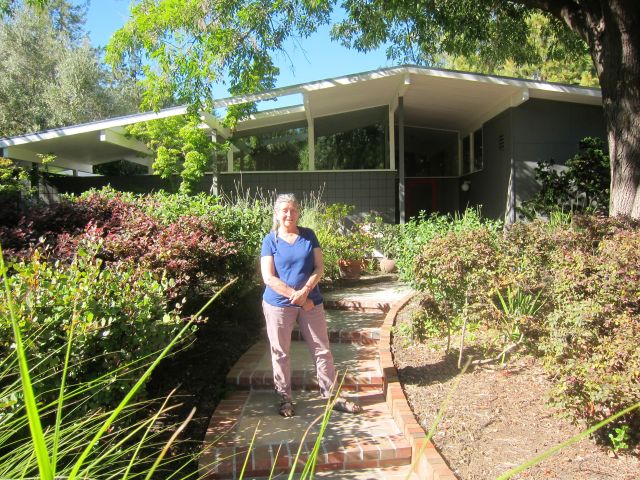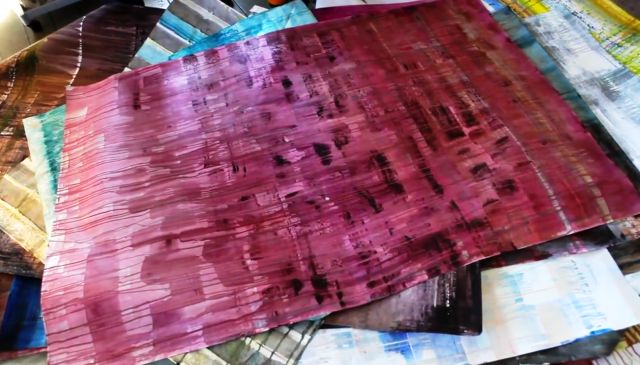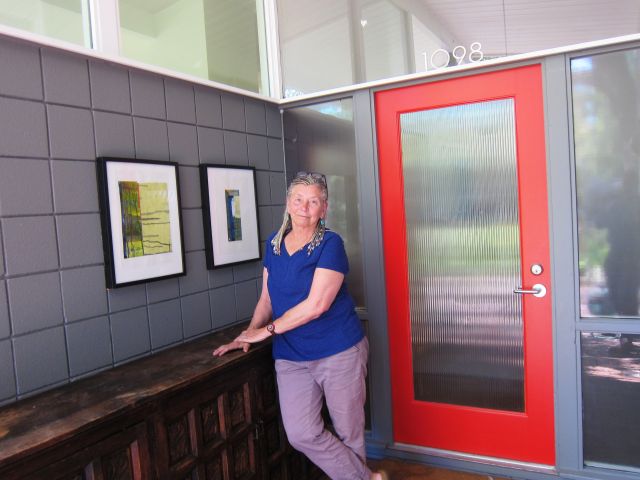
Artist’s Work Was Inspired by Her Eichler
 |
|
|
For years artist Lea Feinstein and her husband, psychiatrist Carl Feinstein, have labored, Lea jokes, as “academic migrant workers,” living in Washington, D.C., Baltimore, and Rhode Island, among other locales, as Carl’s career, primarily, has taken them.
As Carl, who specializes in child and adolescent psychiatry, rose in his field, so did Lea, who has degrees in art history and studio art and a background in art criticism and writing. She was a professor of studio art at several universities and colleges, including Georgetown and George Washington U., the Rhode Island School of Design, and Maryland Institute College of Art.
As an artist who is deeply sensitive to place and time, and to her own life circumstance and story, her art has always reflected her whereabouts, both physical and psychical. Lea is good friends with artist Ealish Wilson, who is also sensitive to place and to architecture, and whom we profile in the new, Fall '17 issue of CA-Modern.
 |
|
|
So it’s not surprising to hear Lea speak so glowingly of the influence her Eichler home on the Stanford campus has had on her work, which these days takes the forms of large, sometimes immense abstract paintings.
“I never would have made anything that I have made if I hadn’t lived in an Eichler,” she says of the work, which she has created in a San Francisco studio. She has recently moved her art practice to Los Angeles but maintains her home in the Bay Area.
When the couple moved to Stanford in 1998 with one of their three sons still remaining at home, they had never heard about Joe Eichler. Carl was joining the faculty, so they were able to buy one of the 770 single-family homes that dot the outer reaches of the campus and are available only to faculty and top administrators.
They had lived in a Queen Anne Victorian before, and their furniture didn’t quite fit. But Lea fell in love.
“It was the architecture of the house and the color. That was huge for me,” she says “I love the light and the color and how the flora and fauna are so close.”
 |
|
|
She also loved the thinking behind Eichler homes. “I love very much the whole democratic idea about Eichler, the multi-ethnic communities,” she says.
When they had lived in Rhode Island, about ten minutes from the shore, Lea says, the landscape informed her art. She was creating “stuff that was basically sticks and rocks and sand, working with things at hand.”
In Baltimore Lea did much performance art, including performances about being a mother, focusing on such seemingly mundane tasks as doing laundry, carpooling, and shopping. “There is not enough performance art about the sacredness and mundaneness of motherhood,” she says.
Before coming to California, she says, painting was not in her repertoire, which was then primarily sculpture and drawing. But then she moved into the Eichler, a spacious 1969 custom model designed by Jones & Emmons, without an atrium.
“I love to work big!” she says, raising her arms high into the air. “And I love to work in relation to architecture. And the architecture of the Eichlers turns me on.”
 |
|
|
The art she began creating was a complement to the home, bringing to it something she believes would be beneficial.
“The modernist box needs something to soften it and warm it,” Lea says. “The Eichler has a good flow with air and light, but it is a rectilinear form -- and I wanted to put something that was organic on the walls. I wanted to make paintings like rivers to run through the house.”
Lea’s current crop of paintings are oils and acrylics and other forms of paint not on canvas but on Tyvek, a waterproof polyethylene material used to wrap house and other buildings, and to encase Fed Ex packages.
She buys Tyvek by the 100-yard roll, cuts it to size, hangs it up, and begins to paint, letting the paint flow downhill as it may. She began using the material, which is not a common artist’s base, well, because she had some around. Then she discovered its practical value.
“It’s cheap. It’s acid-fee. For an artist, acid-free is important,” she says of Tyvek. “It is indestructible.” After a flood soaked some of her paintings, she says, she simply let them drip dry. “They were smooth and flat and there was no puckering. I was convinced after that.”
 |
|
|
In a video about her work Lea says, “All my paintings are meditations on time and flow, a product of time and gravity.” She adds, “My art is about communicating something, a mental state, a state of the moment. And I couldn’t say those things in words.”
To Lea, her Eichler also represents California living and the freedom that comes with that.
“I’m right handed,” Lea says, “but when I came to California I decided to paint only with my left hand.”
“I call my right hand my hand of intention and my left hand my hand of revelation. Because I didn’t judge it. It just comes out.”
“That’s what gave me painting [an art form to undertake],” she says “It’s about moving to California and taking chances.”
Some people who live in modern homes have bought her work, she says, but no Eichler owners. She did one large, temporary installation at the Li Ka Shing Center, the medical school at Stanford.
In Los Angeles, Lea is seeking a good place for her studio and has high hopes. “The market for art there is much better [than the Bay Area],” she says. “It’s going like gangbusters.”
For more on Ealish Wilson, another artist who focuses on art infused by architecture, read ‘Architecture in Fabric’ in the fall '17 issue of CA-Modern.
- ‹ previous
- 53 of 677
- next ›



